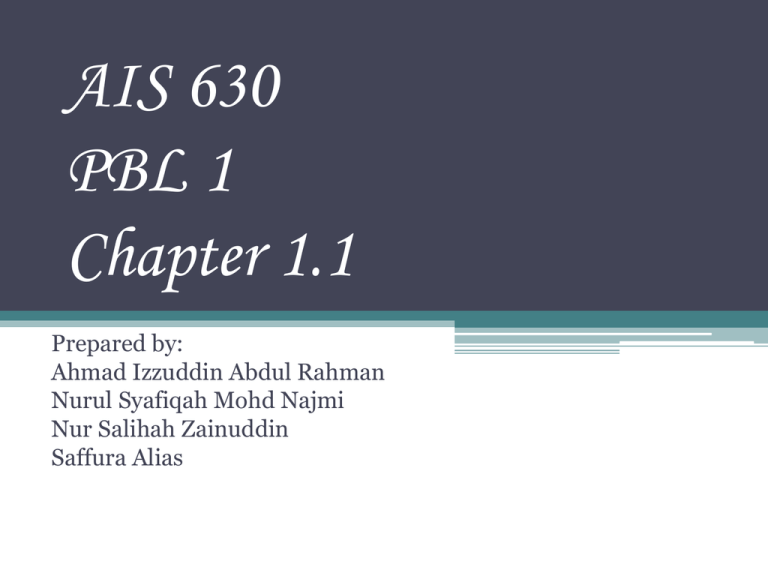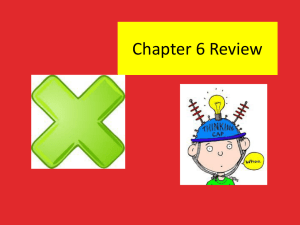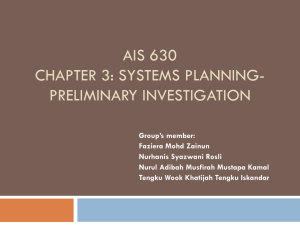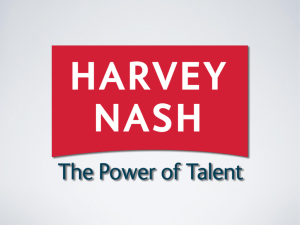AIS_630.258173640
advertisement

AIS 630
PBL 1
Chapter 1.1
Prepared by:
Ahmad Izzuddin Abdul Rahman
Nurul Syafiqah Mohd Najmi
Nur Salihah Zainuddin
Saffura Alias
Main Issue
• The company does not have any computerized
system to records daily entry of sales and
purchases.
Drawbacks of the existing system
• There is uncollected bills and the numbers is keep
increasing
• En. Talhah (account manager) could not keep track
on each customer and his/her outstanding balances
• Some overdue accounts went unnoticed and the
reminders were not sent on time
• Receives complaints from customers that the
competitors are giving discounts to those settling
their debts early from the purchase date.
• Have to go manually (open every files) in order to
keep tracks the accounts which is consuming time
and there may be careless mistakes.
Computer-Based Information Systems
• Information system that uses computer and
communication technology to perform some or
all of its tasks
• Basic components is made up of equipment :
▫ Hardware
▫ Software
▫ Database
Hardware
• Physical components of the computer system
▫ Input device : captures & translate data into a form
that can be processed & used by other parts of the
computer
▫ Computer :
Central processing unit : chip that performs the
instructions that receives from the software
Internal memory : hold software instructions &
information for the central processing unit
▫ Output devices : provide copies of data and
information on paper and others
▫ Modems : input/output devices that allow a computer
to transfer data between each other
• Based on the situation, the company does not
have hardware to be used since they are using
manually.
• The accountant need to write the invoice by
herself because the company does not have
printer (output device)
Software
• Set of instructions to process the information
• Database software : software that allow you to
arrange, modify and extract data from a
database to create information
• The company still does not have software to
operating the business
• In future they are planning to creating a
software to detects customer that willing to pay
early and give discounts to the
TELEC0MUNICATI0N
• Vital c0mputer based t00l t0 help
c0mmunnicate inf0rmati0n t0 pe0ple in 0ther
l0cati0n.
• “There are als0 cust0mer wh0 did n0t keep us
updated n their current address when they
m0ved” {paragraph 2, sentence 7}
Netw0rk
• C0mmunicati0n techn0l0gy can share res0urces
such as st0rage database & pr0cessing p0wer.
• May received & send inf0rmati0n with 0ne
an0ther.
• “The inv0ice is then mailed t0 the cust0mer”
{paragraph 3, sentence 5}
• Reduce c0st & time c0nsuming
PE0PLE
• Part 0f inf0rmati0n system includes
management and als0 end users.
• Management= inf0rmati0n f0r decisi0n making
• End users= t0 supply and received data fr0m
inf0rmati0n systems.
• Cik Siti can efficiently identify their g00d
paymaster t0 give disc0unt just like their
c0mpetit0rs {paragraph 2, sentence 9}
PR0CEDURE
• Series 0f steps in prescribe manner t0 ac0mplish
a certain j0b.
• Written f0rm 0f manual 0r d0cumentati0n such
as diagram.
• {paragraph 3, sentence 3 – 14}
DEVELOPING AN INFORMATION SYSTEM
• This system is known as system development
life cycle.
• There are five phases in this system.
Systems Planning.
Systems Analysis
Systems Design
Systems Construction and Implementation
Systems maintenance
SYSTEMS PLANNING
• Consists of proper long-term and short-term
planning.
• Preliminary investigation.
• Three important arrears.
the problem inccured in Qaisara is no computerbased information system to record transaction
systematically in their business. For example : all
document are prepared manually by accountant
clerk.
the goal to create the system is to make
systematic accounting system. So that, En Talhah
only need short time to trace customer details and
there is no more unnoticed document and the
reminder will send on time.
Limitation to build the system when Rafiq cannot
straightly build a the system because he need to
get approval from his uncle.
SYSTEM ANALYSIS
• Detailed understanding of important features.
• Finding out how the existing systems works.
The existing system in Qaisara is manual system.
For example: when the clerk received the sales
order from the sales department the clerk will put
it in the file. When the clerk receive delivery order
from the warehouse, the clerk will reconcile it with
the sales order and prepared invoice manually.
Used fact-gathering technique in search for
information about the system.
Interview users. Rafiq interview Cik Siti.
Review key documents
Do observation.
This phase result in a detailed proposal of the new
system describing the system function, system
data, and system information flows.
system function : to solve the problem happen in
recording manually.
System data : computerized billing and collection
system.
System information flow : Rafiq talk to En Talhah
about the computerized billing and collection
system.
SYSTEM DESIGN
• The information need and system requirement
propose in the systems analysis phase are
studied in more detail and put into design
specifications.
Rafiq meet his friends, Zain, Tasya, Nadia and
Kamal to ask detail about the system.
• General systems design- need to develop the
system and software to used.
Rafiq meet his friend to ask them about the
suitable system and software to be used.
• Documented all the general system.
After Rafiq meet En Talhah, En Talhah suggest to
him to make a proper proposal about the system
request.
SYSTEM CONSTRUCTION AND
IMPLEMENTATION
• System is actually being develop. Since the
computerized billing and collection system is
still in progress the system is not in the phases
yet.
• Consist of two-phases:
system construction : the individual system
components are build. New programs and changes
to existing programs are written and tested.
System implementation : the components built
during construction are put into operational
used.
SYSTEMS MAINTENANCE
• To eliminate errors in the system.
• To fine-tune the system to any variation in its
working environment.
• Maintenance implies that there is continuous
improvement.
• To upgrade their new systems.







